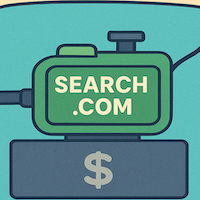About a decade or so ago marketers glanced at the big box sitting on their desks and thought, “hmmmm bet we can make some money doing advertising on this thing.” And so e-mail marketing was born.
At the time it was considered a fluke. Now people, (like me) who don’t have a BlackBerry or IPhone to be uber e-mail-connected are considered non-adopters.
Shortly thereafter, large brick-looking contraptions called mobile phones emerged. They were heavy, they were bulky …and then all of sudden things changed. When I got my first mobile phone it was a PrimeCo. (Remember them?) At the time I got promotional text messages from the company offering services….and guess what happened? Advertisers (who may have gotten such a promotional message from their own carriers) looked down and went, “hmmmmmmmmmm.”
Then, just a few years back everyone joked that people were on their cell phones so much there needed to be a way to Velcro it to the side of their heads. Cue the arrival of the wireless headset. Now, welcome to the next generation of SMS called, Bluetooth Proximity Marketing.
Next generation? Whoa Nelly! Where’d that first generation of SMS marketing go already? Here’s the news blast: If you’re not SMS-ing with your clients, your competition has beat you to the punch.
But don’t worry. Here’s your SMS Crash Catchup Course.
First, the basics:
*WAP- Wireless Application Protocol: Enables access to the Internet from a mobile device. Examples of WAP uses: live clickable link in a wireless message, video, click to talk.
*SMS – Short Message Service Text Messaging: A text message delivered to a cell phone. Message delivers information but does not contain live links. It is the only technology that every carrier currently supports, limited to 140 or 160 character messages. Examples of SMS uses: coupon codes, voting, information.
*Aggregators: A service conduit across all carriers.
*Short Code: The five- digit client code that is shared across carriers.
*Keyword: The opt-in mechanism that consumers text in to initiate an action.
How are SMS/WAP messages sent?
SMPP vs. SMTP: SMS messages sent over SMTP are actually routed from the Web to cell phones. This causes many deliverability problems for messages. Only two carriers allow SMTP messaging. And after 50 messages they cut it off. So SMTP is not a viable method of transmitting SMS messages for advertisers.
Sending a text message via the SMPP protocol is a true way to send a text message. The Short Message Peer-to-Peer (SMPP) protocol is a telecommunications industry protocolfor exchanging SMS messages between SMS entities. With SMPP, you can receive information such as successful and failed deliveries, and why a text message failed.
Pull campaigns (or SMS keyword campaigns) are promoted to a general audience. Viewers are prompted through a tag on a TV or radio spot, in a print ad, billboard, etc. to l text in. (This is the type of message used by “American Idol.”) A great example of this is the “Text ‘n Win” or “text to Vote” style campaigns. You are “pulling in” recipients.
Outbound campaigns (push campaign) go to an opted in audience such as a cost-per-thousand or subscriber list. They deliver timely actionable information or offers. You are “pushing” a message out to a list of opted in recipients.
So how do you get started?
Pull (SMS keywords:) You can put keywords into any advertising medium to make it immediately interactive. It is an inexpensive, very fast way to start building your SMS database for future marketing.
Appending: In addition to contacting your existing database to opt-in subscribers for mobile updates, you can append your list. Just like you would append for e-mail addresses from a postal file, you can append your in-house list for SMS records and be on your way!
Push: Just as you would rent a targeted list to send out a targeted e-mail, you can micro-target consumer campaigns to an opted-in SMS list. This type of messaging is very effective for driving traffic to both bricks-and-mortar as well as virtual storefronts.
Bluetooth Proximity Marketing: A transmitting device is placed at a specific location such as store, auto dealership, restaurant, tradeshow booth, event location, etc. and a mobile message and proximity range is uploaded via the web to the device’s software application. The device then broadcasts the message, without going through the carriers, to every Bluetooth enabled cell phone with the proximity range. This is remarkably effective for driving traffic.
The Bottom Line
Technology is advancing at lightning speed. If you want your business to advance, you need to be where your customers are spending their time.
Oh, I’m sorry. Do you need to get that new message on your cell phone?
Yes, you do.
Carol Lustig is marketing director Options Media/1Touch Marketing, Boca Raton, FL.
 Network
Network

